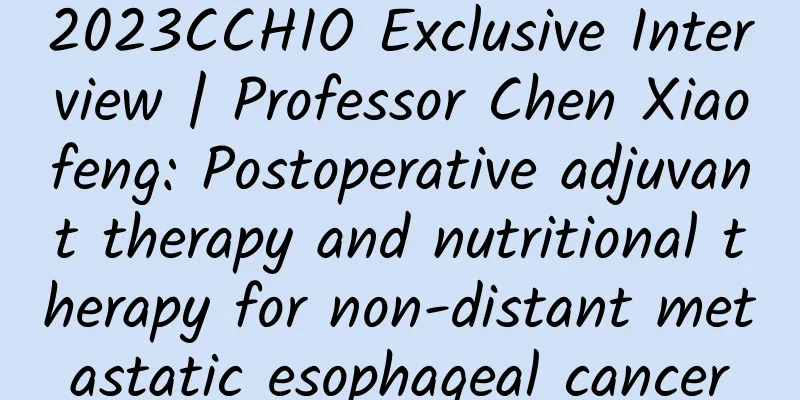2023CCHIO Exclusive Interview | Professor Chen Xiaofeng: Postoperative adjuvant therapy and nutritional therapy for non-distant metastatic esophageal cancer

|
Recently, Professor Chen Xiaofeng from Jiangsu Provincial People's Hospital shared his experience on postoperative adjuvant therapy and nutritional therapy for non-distant metastatic esophageal cancer. Whether or not postoperative adjuvant therapy is needed for esophageal cancer, as well as the specific methods of adjuvant therapy, should be determined based on the specific pathological condition of the patient after surgery. The main purpose is to prevent the recurrence or metastasis of esophageal cancer as much as possible. Professor Chen Xiaofeng Associate Professor, Associate Chief Physician, Master Supervisor, Department of Oncology, Jiangsu Provincial People's Hospital Standing Committee Member/Deputy Secretary-General of Tumor Nutrition Committee of China Anti-Cancer Association Member of the Standing Committee of the Esophageal Tumor Integrated Rehabilitation Committee of the Chinese Anti-Cancer Association Member of the Colorectal Cancer Committee of the Chinese Anti-Cancer Association, Integration of Traditional Chinese and Western Medicine Vice Chairman of the Hereditary Tumor Professional Committee of Jiangsu Integrative Medicine Research Association Vice Chairman of the Tumor Nutrition Committee of Jiangsu Anti-Cancer Association Standing Committee Member/Secretary of Jiangsu Provincial Association of Research Hospitals for Precision Treatment of Hepatobiliary Tumors Edited 4 clinical research monographs and published more than 40 SCI papers Therapeutic efficacy of immune checkpoint inhibitors in adjuvant therapy For postoperative adjuvant treatment of esophageal cancer, positive results have actually been obtained in 2021. When the check mate577 study was released, it caused a great sensation. For patients who undergo neoadjuvant synchronous chemoradiotherapy and then undergo radical surgery, if the pathology after surgery does not reach PCR, adjuvant immunotherapy is recommended. This study comes from the famous check mate577. One group of patients included in this study did not reach PCR after synchronous chemoradiotherapy, and the other group used European medicine for adjuvant treatment. The results showed that the difference in survival time between the two groups was very obvious, and the survival time of the experimental group was doubled that of the control group, so it was approved. There are also some defects in this study. The proportion of patients with squamous cell carcinoma is small, and there are not many Asian patients. For the clinical practice of our Chinese patients, whether we can definitely benefit from such treatment, there are actually some questions. In addition, in the 577 study, the survival time of the experimental group and the control group was not long, the control group was only 11 months, and the experimental group was 22 months. So I think for a patient who has undergone radical surgery, the clinical studies conducted in China actually perform radical surgery after synchronous radiotherapy and chemotherapy. The DFS time is very long, ranging from 60 to 80 months. So for this 577 study, the control group only had 11 months and the experimental group only had 22 months. Is it applicable to the specific treatment situation in China? In fact, it is not entirely true. Therefore, we need more clinical research. Durvalumab has also been studied in a single-arm multicenter clinical study to see whether postoperative immunotherapy after neoadjuvant therapy can help patients gain better survival benefits. In this area, we can refer to the results of 577. Neoadjuvant therapy can be considered for some high-risk patients. However, we cannot simply copy and generalize this treatment model, as not all patients receive postoperative adjuvant therapy. It should also be noted that in our guidelines, it is only recommended that patients who have undergone neoadjuvant synchronous chemoradiotherapy should consider subsequent immunotherapy; for patients who did not use synchronous chemoradiotherapy but only used chemotherapy alone, we recommend postoperative adjuvant chemotherapy in the guidelines, so specific situations need to be treated differently. Suggestions on improving nutrition for patients after esophageal cancer surgery Tumors of the digestive system, especially those of the esophagus and stomach, are easily accompanied by malnutrition. We have established principles for the diagnosis and treatment of malnutrition. For example, we need to comprehensively evaluate the patient's nutritional risk and degree of malnutrition by doing the NS2002 score, the PGSGA score, and the GLIM score. Different treatments are given according to the nutritional risk and degree of malnutrition. The main principle followed in treatment is that if the patient can eat but not enough, we recommend ONS, or oral nutritional supplementation. If oral nutritional supplementation is not enough for the patient, we will consider doing some intravenous nutrition, that is, partial intravenous nutrition plus partial enteral nutrition. If partial enteral nutrition is not enough, the patient needs total parenteral nutrition. There are many practical problems in the treatment of esophageal cancer. For example, esophageal cancer patients often have eating obstruction. Then we need to provide patients with nutrition tubes to supplement enteral nutrition through nutrition tubes; or supplement enteral nutrition through foci fistula. For patients after esophageal cancer surgery, the patients usually have thoracic stomach, but the patients' stomach and intestinal functions are intact. Therefore, for patients after esophageal cancer surgery, we recommend eating small meals frequently, because most patients after esophageal cancer surgery will feel uncomfortable if they eat too much at one time, and eat high-quality nutrients, high protein, or even high-fat nutrients. In this way, under the premise of normal gastrointestinal function, patients can get enough nutrition. For patients who do not have sufficient gastrointestinal function, such as patients who have esophageal cancer and have also undergone partial gastrectomy, they should pay more attention to oral nutritional supplements in the intestine. Because the function of the stomach is to grind food, then perform preliminary digestion, and then enter the small intestine, patients who have lost stomach function or partially lost stomach function do not have the function of grinding and cannot perform the first step of processing. After taking enteral nutrition solution or enteral nutrition powder, patients can directly absorb it in the small intestine. In addition, some patients may have a misunderstanding that patients after esophageal surgery should eat a light diet. In fact, this is not the case, because only by giving patients a high-energy, high-protein, and high-fat diet can patients get enough energy. Patients should have enough nutrition and should not be picky eaters. When we prepare food for patients, we must also be comprehensive and sufficient, and meat, vegetables, vitamins, etc. need to be fully supplemented. |
Recommend
There is a small fleshy lump next to the breast
A small lump of flesh next to the breast may be a...
Flurry: 88% of iOS 14.5 users worldwide choose to turn off app tracking
It’s only been two weeks since Apple introduced i...
Is the second uterine curettage painful?
Female friends who become pregnant unexpectedly w...
Is there any relationship between infertility and curettage?
Nowadays, many female friends are prone to accide...
Do you think the "cracking" sound in the joints comes from the bones? | Illustrated Science
What is the "cracking" sound coming fro...
Does the ring have any effect on the body?
There are several contraceptive methods for women...
When can I have sex after salpingography?
When women undergo physical examinations, they sh...
What causes back pain during pregnancy
After learning that they are pregnant, relatives ...
Can acupuncture cure infertility?
Acupuncture is a part of traditional Chinese medi...
How does cervical cancer develop?
Talking about cervical cancer, I believe most of ...
If you are not overweight, have a big belly, and feel tired in your waist, it may be that you have an anterior pelvic tilt!
When it comes to posture problems, the most commo...
What are the dangers of women crossing their legs?
Both men and women like to cross their legs while...
Don’t be afraid of cervical cancer. Do these three things to stay away from it!
Cervical cancer is the most common malignant tumo...
What are the benefits of red bean and barley tea? Is red bean and barley tea cooling or hot?
Red bean and barley tea is a tea made of adzuki b...
Vulva redness and swelling after sex
Many women feel very shy when it comes to having ...









